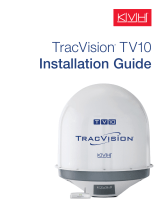
NMEA Autoswitch - NSW-1-B
Page 5© 2005 Active Research Limited
General features
4 NMEA 0183 data input ports
Each NMEA 0183 input port has a priority level. This is fixed
to the logical order that matches the port numbers, i.e. port
1 has the highest priority and port 4 has the lowest.
An NMEA 0183 autoswitched data output port
This output port has the automatically switched NMEA
data from the highest priority input port currently receiving
valid NMEA data.
The NSW-1 autoswitch contains special algorithms to
control the selection of the highest priority input port:
1. The input port has to be receiving NMEA data.
2. The received NMEA data has to pass the NMEA
sentence checksum test - failure of this test indicates
that there has been interference and/or loss of signal
in the reception of the data.
3. Any status flags contained within the NMEA data
have to be of a valid nature. An invalid flag indicates
that the data should only be used if no other data
is available, and then only with caution. The device
used to display this NMEA data will determine how to
show/indicate the caution status of the NMEA data.
A PC compatible RS-232 bi-directional port
This output contains the same data as the NMEA 0183
autoswitched output, only using the Baud rate of 38400.
Technical features
High-speed micro-controller capable of 10 million
instructions per second.
Flash ROM technology that supports automatic
programming for quick and easy updates, 10,000+ erase
cycles and a 10-year Data Retention provides carefree
user configuration.
On-chip memory store allows buffering of short term
NMEA data, allowing the unit to smooth short-term peaks
in the NMEA data flow.
NMEA 0183 inputs are opto-isolated differential inputs to
fully comply with the NMEA 0183 standard specification.
This allows the inputs to work correctly with long cable
runs and in a noisy environment. Typical operating voltage
is 2.0v to 15.0v. Typical operating voltage is 2.0v to 15.0v.
The unit can withstand +/- 35v continuously, and +/- 40v
transients. The Opto-isolator can protect any upstream
equipment (chart plotter, laptop PC, radar etc.) from up to
2000v of common mode voltage difference.
NMEA 0183 full-differential output driver. This can drive
up to 15 fully compliant NMEA 0183 device loads, with a
30mA (maximum) drive capability. The full-differential
output ensures better quality communications and lower
noise emissions on unshielded twisted pair cabling.
Full specification RS232 interface ensures that any
marine electronic device (or PC) that has an RS-232 port
receives the autoswitched NMEA data. This connection
also allows the unit to be updated via the free flash upgrade
software that will be made available on the Actisense™
website if the NSW-1 software has been enhanced.
Wide battery input voltage range to offer maximum
compatibility, the NMEA 0183 Buffer NSW-1 can operate
from a battery supply anywhere between 8 and 35 volts.
Low Power Consumption that is typically 26-30mA at 12
volts and 16-18mA at 24 volts.
A diagnostic LED indicates the operation mode of the
NSW-1, if any faults have been detected, or the peak load
currently on the highest priority valid NMEA input port.
Very tough Polycarbonate case is certified to IP66
(classified as “totally protected against dust and protection
against low pressure jets of water from all directions”).
Being Polycarbonate, it is also incredibly strong, offering
a wide temperature range and superior protection to the
electronics inside. The IP66 rating of the case is only
limited by the sealing gasket strip, which can be enhanced
by applying a suitable non-acid based marine sealant to
the gasket after wiring and testing. This will allow use of
the unit in areas where salt spray could enter, accidental
immersion may occur, or in environments where maximum
long-term reliability is paramount.
Robust ABS grommets are certified to IP68 (classified as
immersible for long periods without water ingress). Note
that to achieve this level of water integrity all grommets
must be occupied by round-section cables.
Large range of possible cable diameters of between
4.5 mm and 10 mm, single or multi-pair wire types can be
easily accepted.
Software updates
The NSW-1’s built-in firmware is held in “flash” memory,
allowing quick and easy upgrades using a simple Microsoft
Windows (95/98/ME/NT/2000/XP) user interface program
(Flash Centre) running on a connected PC.
It is our policy to provide these updates free on our website,
www.actisense.com, so that your autoswitch can become
more sophisticated with time, and should there be any
bugs reported in the software, they can be promptly fixed
without the unit coming out of commission. This upgrade
can be performed with the unit completely in-situ, via a PC
connected to the RS232 port.




















